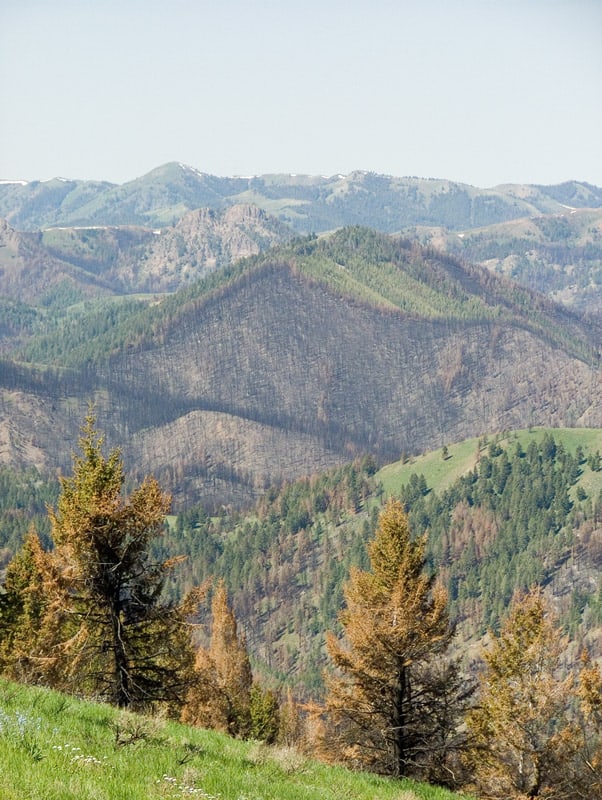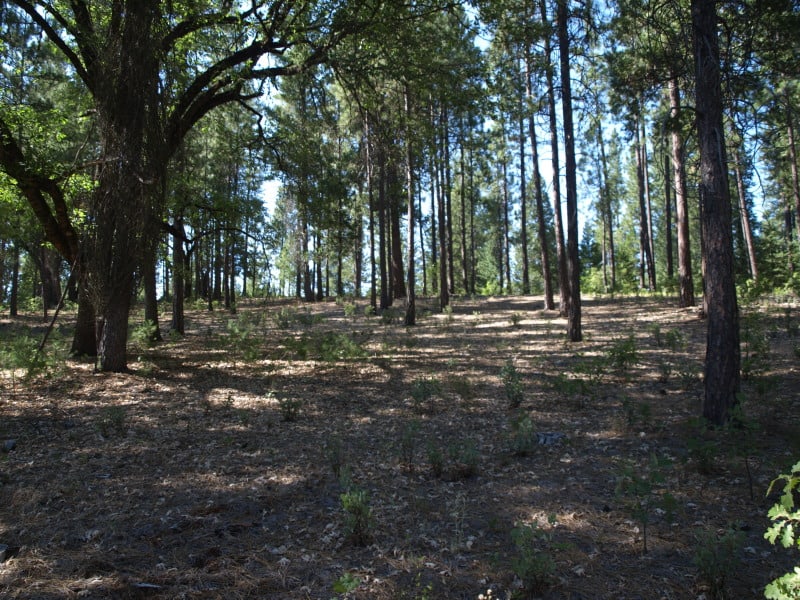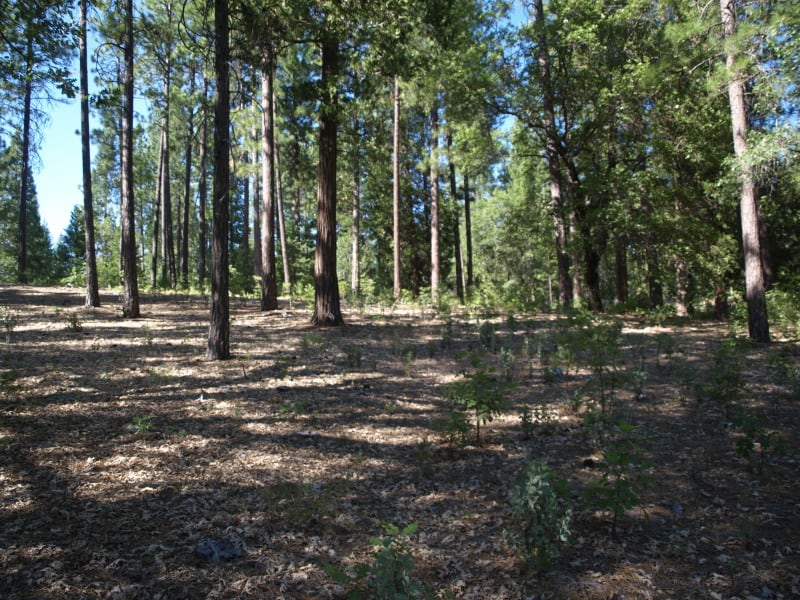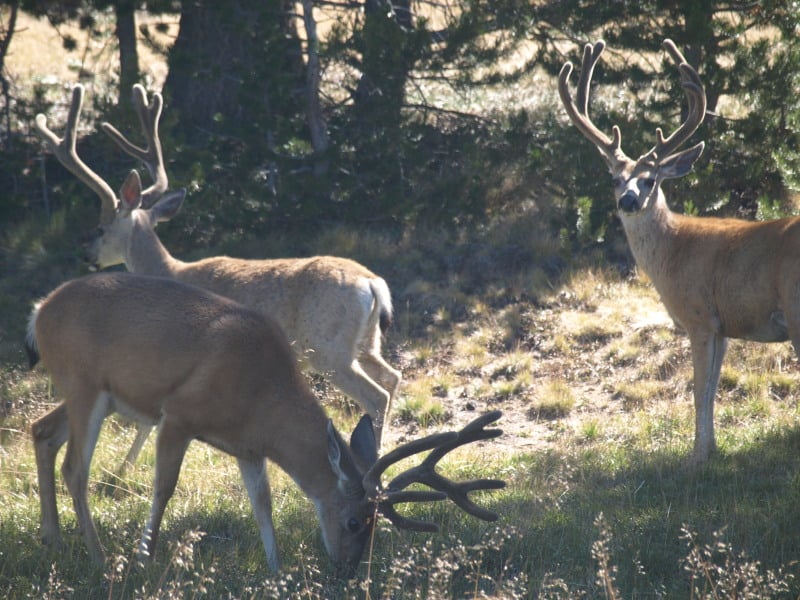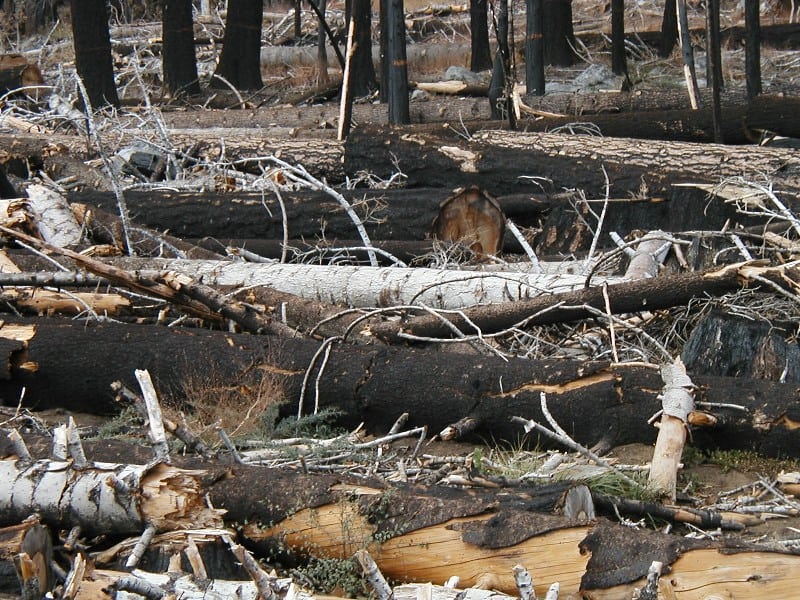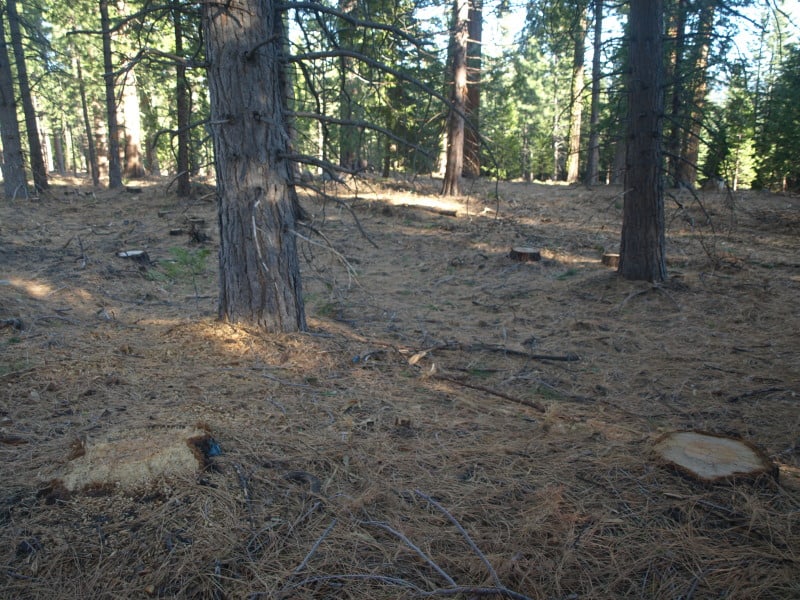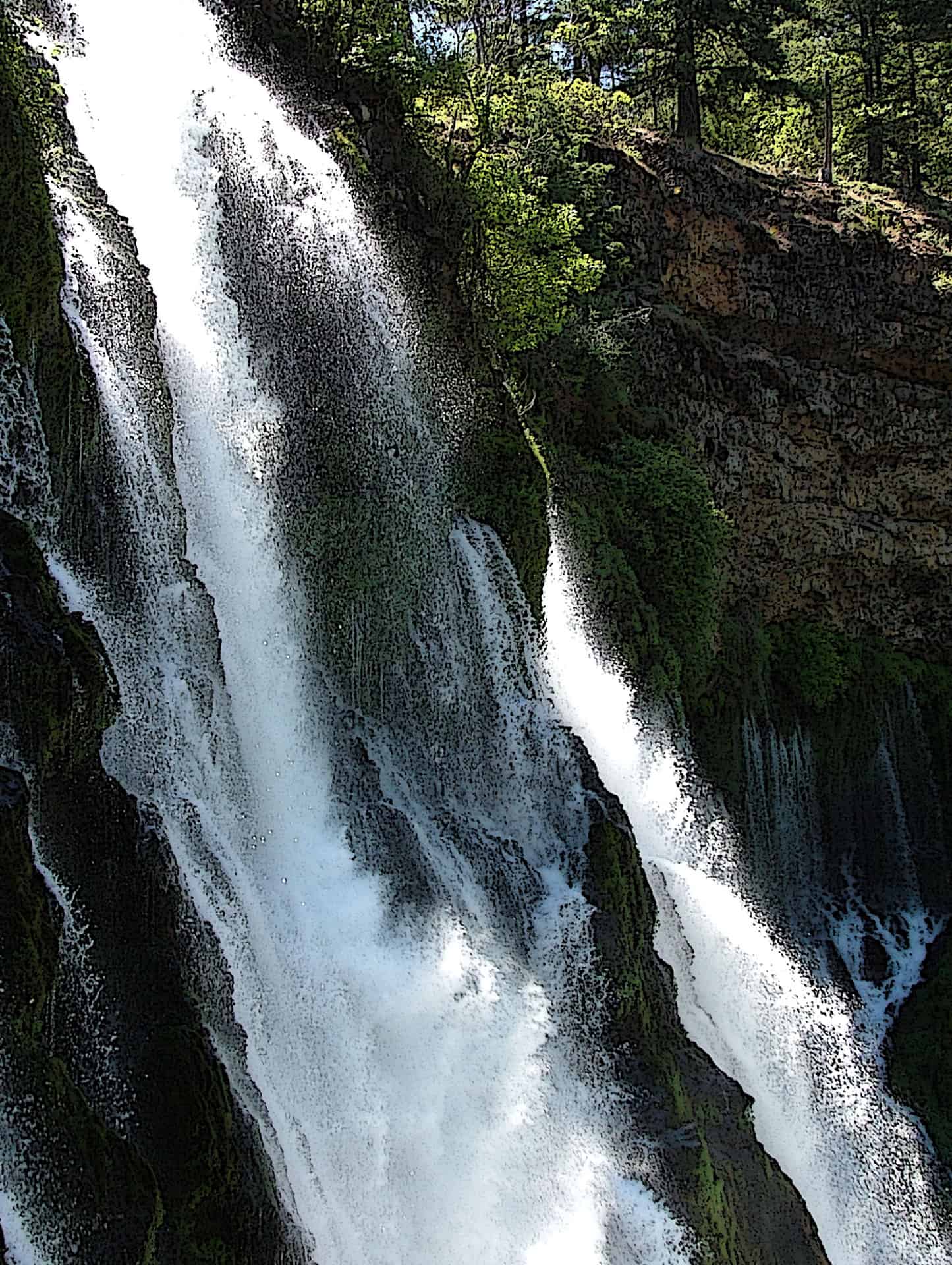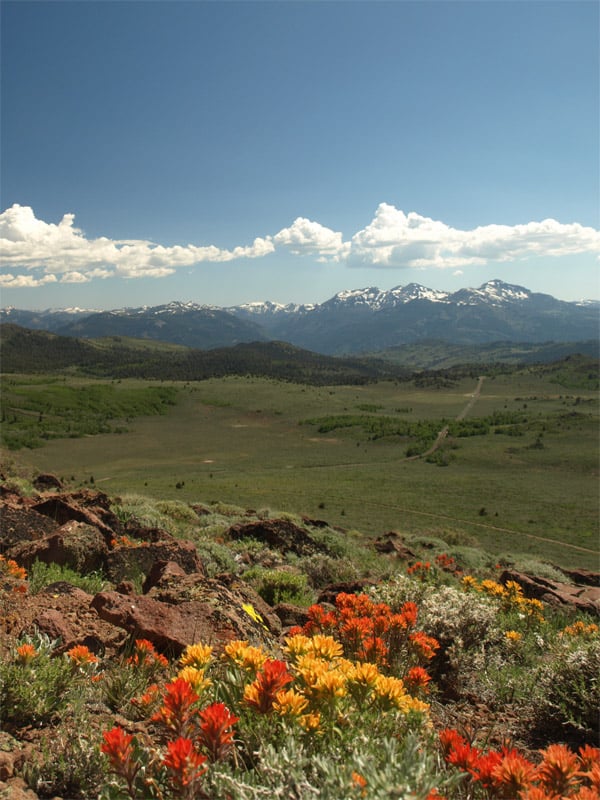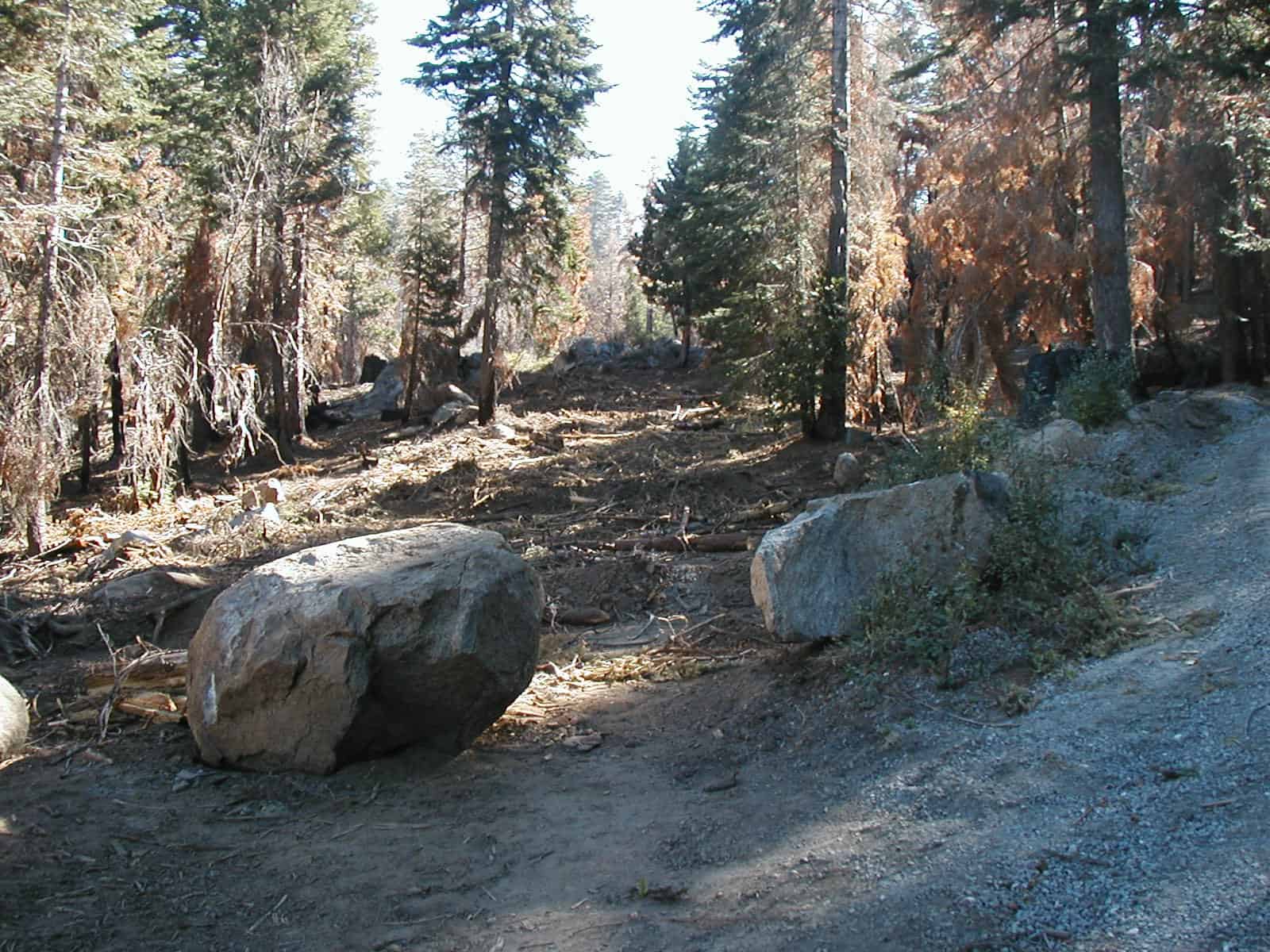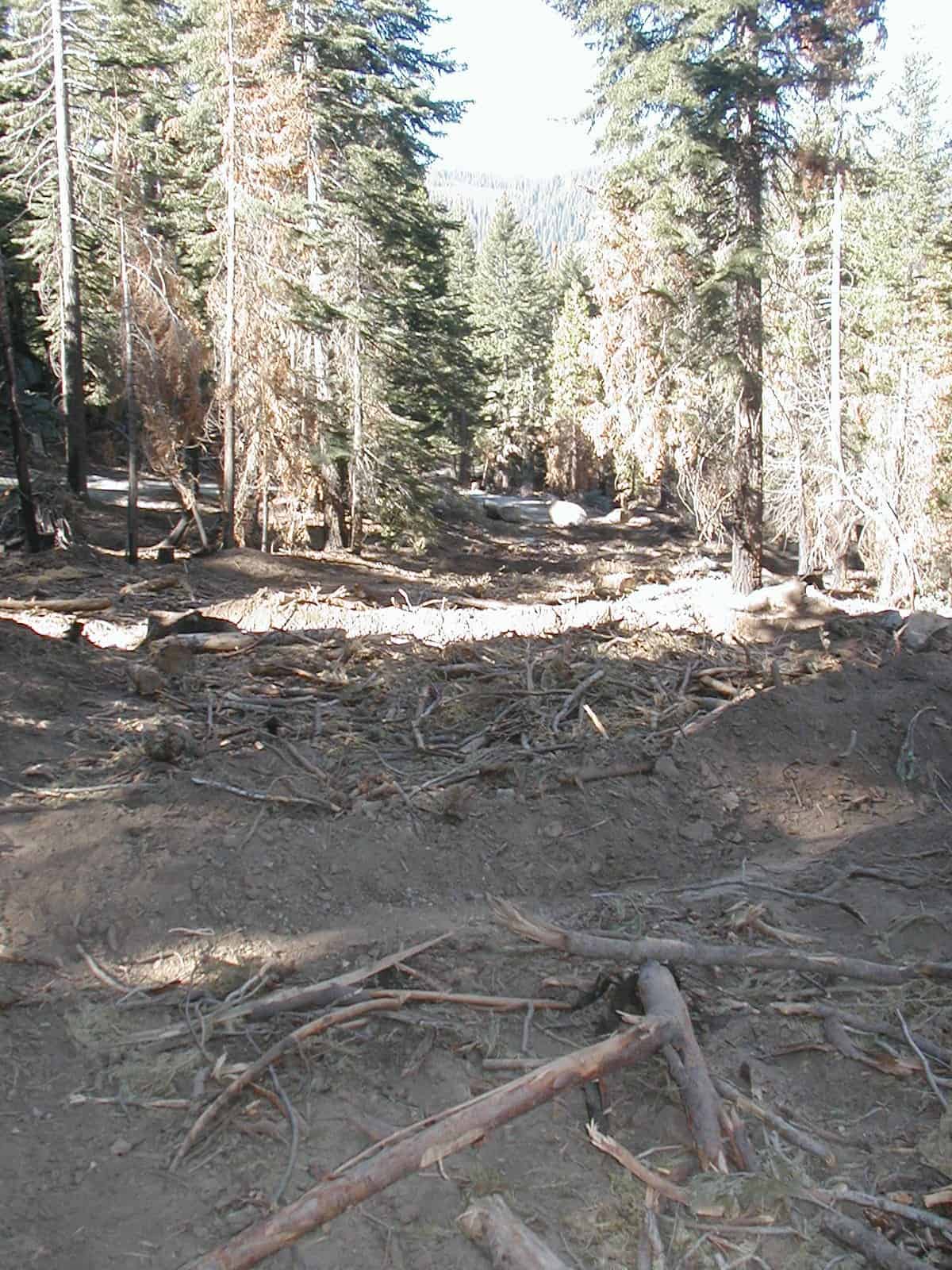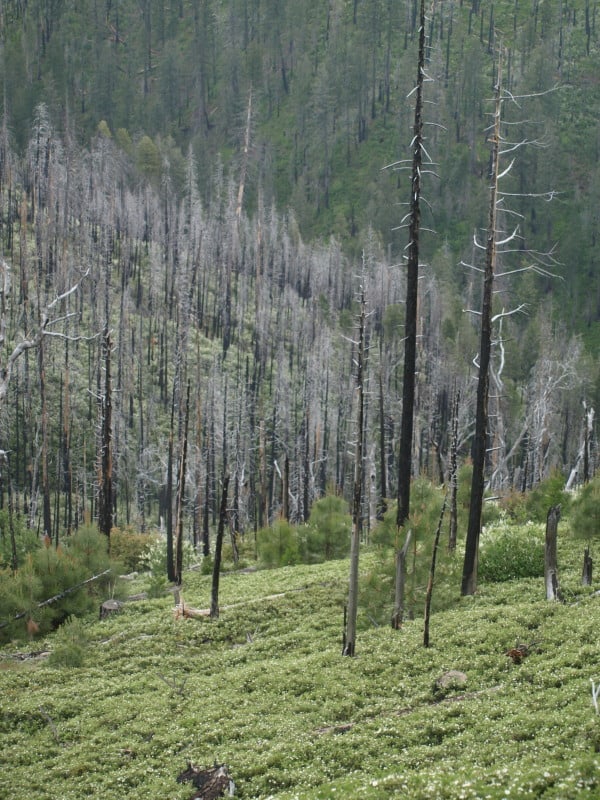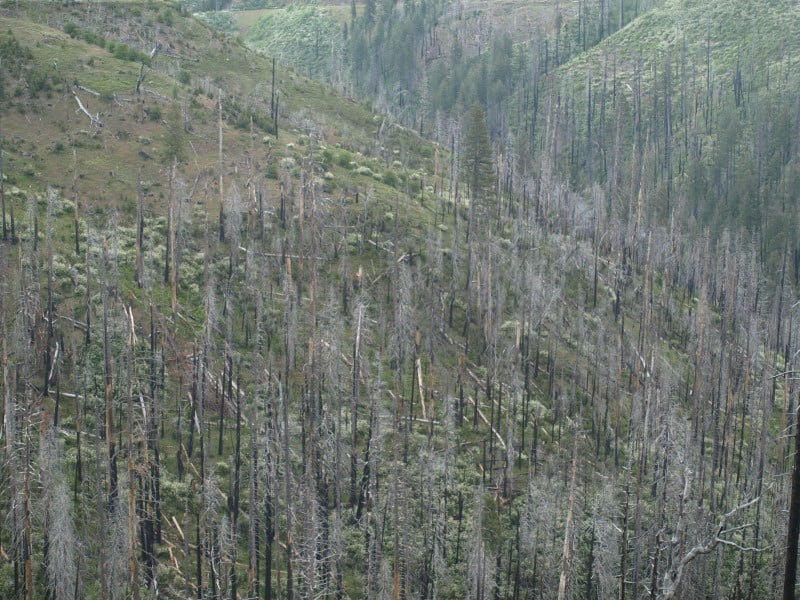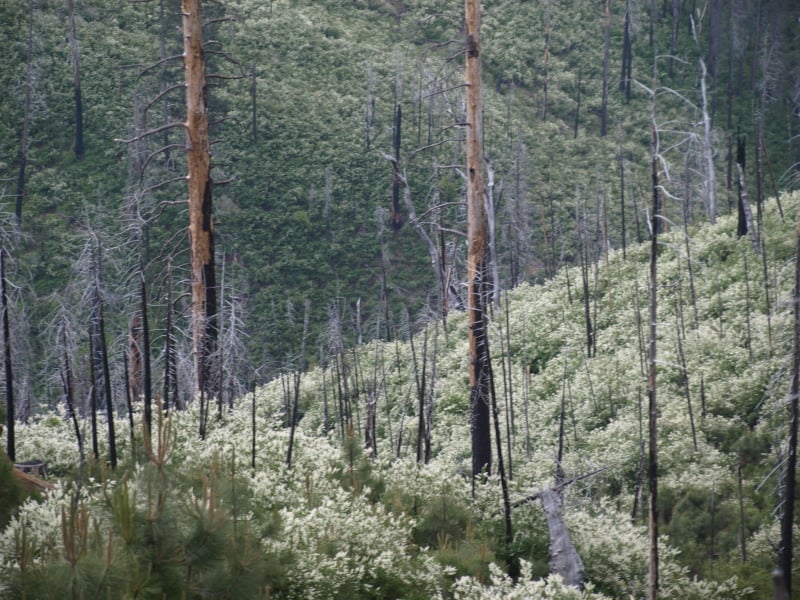The Beaver Creek Fire has burned over 90,000 acres of the Sawtooth National Forest. This is a view (from the top of Sun Valley Ski Area) of the land after the Castle Rock Fire, of 2007. The Beaver Creek Fire is burning up to and into the footprint of the old fire. As you can see, the fires here can jump around a lot, finding new “jackpots” of fuels, on the north-facing slopes. Some of the acres burned are grass and sagebrush, too. Yes, there ARE some VERY fancy homes in and around the town of Ketchum. Will this be the fire that burns down part of the community?
wildfire
Roadside Fuels Project
While driving to Yosemite the other day, I passed through the Stanislaus National Forest on California Highway 120. I’ve seen this project for several years, and decided to stop and see how it looks a few years after completion. These strips are adjacent to the highway for about 6 miles, on both sides of the road. The previous condition had thickets of “whippy” pines, and manzanita brush, making groundwater very scarce at this 3000-4000 foot elevation. I did see some “old growth” manzanita “stumps”, and it looks like very little commercial-sized timber ( over 10″ dbh) was removed.
I did see where the manzanita was “stump-sprouting” but, their growth will be limited in the shaded areas. Certainly, a mosaic of brush is inevitable but, it appears that the focus of this project is to reduce fuels along the main source of ignitions. It also provides a safe corridor where emergency vehicles can get to where they need to go. This project also seems to give forest development a nice “nudge”, reducing the amount of time needed for larger trees to grow. It will also safely allow the use of prescribed fires, to control future “fuels”.
Now, I am not sure if this was a “Service Contract”, or a part of a larger timber sale. It really doesn’t look like they removed enough value to pay for the non-commercial tasks. However, this is a good example of necessary things that should be paid for with sustainable forest management.
OK, OK….. I’ll post a picture from Yosemite!
I saw no less than 30 bucks around Tuolumne Meadows, including an 8 or 9 pointer! Pics on my page!
www.facebook.com/LarryHarrellFotoware
Democrats Comment Against Forest Thinning
Here is an early July LA Times article that, apparently, says that only Republicans are seeking to thin our forests, as we watch our forests burn. Clearly, this is a tactic to rile up their mostly Democratic readers.
http://www.latimes.com/news/nation/nationnow/la-na-nn-gop-fire-hearings-20130703,0,2185679.story
Yes, it did rile them up, as evidenced by the wild comments. Here are a few examples:
As a logger in Susanville, California said at a Forest Service public comment session (1997), “But Trees are Dying in the Fiorest”!!!! (and therefore NOT making a profit for him).
My response, People are dying in the streets, so what is YOUR point.
The aLand Raping Logger coundn’t answer, because the only thing he cared about was turning a PUBLIC RESOURCE into his own private profit.
Dead trees in a dorest serve as nesting sites for birds and other animals and eventually fall to rot, providing food foe grub eating bears, light spaces for juvenile trees to start and replenishing the forest soil, for the next generation of trees.
When a person dies, what good do they do the Planet?
This commenter doesn’t realize that clearcuts have been banned in the Sierra Nevada for over 20 years.
The logging companies will only clear cut…not select cut, making for the ugliest scars and worse…ecological destruction of forest habitats. This is not a good idea. The problem is not the density of trees…it’s the residential areas built near thick forests. Bad planning is a result of homes destroyed in forest fires.
Ummm, I think it is the wildfires that are causing “deforestation”, bud!
Is that what the GOP is calling deforestation for profit these days, as they bend over for their lumbering lobbyists?
Was this supposed excessive harvesting done in THIS millennium??!?
They have a point, but the GOP has a history of letting “thinning” evolve into excessive “harvesting” by lumber companies.
This person is in denial about current forest management practices that have eliminated high-grading AND clearcutting, while reducing fuels in the form of trees in the 10″-18″ dbh size class. The last 20 years of active management has not resulted in adverse effects. On the other hand, wildfires lead to MORE insects, as they kill the fire-adapted pines, through a combination of cambium kill and bark beetle blooms.
Much of the GOP have forest management/preservation for the past 40 years. While some may see forests as natural resources to be preserved and cherished, others see them as purely economic resources to be exploited. Timber interests in California have utilized the same pretext to no avail. Note that thinning the forests would have little effect in preventing or curtailing wild fires. Let nature take its course becasue fires are a natural occurance; and are necessary for killing insects, spreading new seeds and burning away dead wood.
Really, though, THIS is a big part of what we are up against. Loud-mouthed partisan politics, not based in fact, is harming our ability to do what is right for the “greatest good”. Shouldn’t we be “thinking globally and acting locally”, regarding forests? Is this mindset fitting into “If you are not part of the solution, then you are a part of the problem”?? It looks like commenters will say ANYTHING to bash the GOP, even if it is hyperbole and rhetoric. Sadly, this ignorance of forest facts continues to have a harmful and hazardous effect on our forests.
The Return of Let-Burn
Sadly, we get the same results as we’ve gotten in the past. When you “preserve” wildfires for weeks, the winds eventually come up and fires can (and will) escape. Now, all sorts of scarce resources will be tied up for an unknown amount of time, impacting other current and future wildfires, during an intense heatwave. How many Forest Service recreation opportunities will be closed up, due to wildfire concerns? How long will these wildfires continue to impact humans living close by? How many tens of millions of dollars will be wasted on these “resource benefits” touted by fans of “free range” wildfire? How many fuels reduction projects will have to be delayed, because fire suppression has “stolen” their funds? These questions need answers but, no one wants to answer them. “Unforeseen weather conditions” is an unacceptable answer for losing containment. Mountains and winds always go together!
From the Evergreen Magazine’s Facebook page:
The South Fork Fire: A firefighters perspective…
This was sent to us by a firefighter friend of ours. Lack of management in the forest is costing hundreds of thousands of dollars, taking lives and homes, decimating the land, wasting timber, and natural resources as well as dumping large amounts of CO2 and carcinogens into the atmosphere.“The following message was forwarded by one of my Smokejumper Bro’s. For many years he was a lead plane pilot and has seen a lot from the air.
The temperature at 7500 ft in Los Alamos today reached 94 deg F. The winds were light however we can no longer see Santa Fe and the Sangre de Cristo Mountains because of the smoke from the Jarosa fire. Unfortunately this will drive the fire further into the Pecos Wilderness and no suppression will take place until ti crosses the wilderness boundary.
The Silver Fire is now listed at 85,000 acres with 10% containment according to the news reports.”
Subject: Feds, Fires, Frustration — CO (Lengthy)
“With the understanding that I’ve been wrong before, that I don’t have access to a lot of information and that I might be wrong again, here’s my opinion:
1. Background
The forest is in bad shape due to drought and the beetle infestation. There’s a LOT of standing dead timber and associated brush. In short, it’s a disaster waiting for the proper time to happen and it needs to be carefully watched by people with serious understanding of the potential problems. The right people weren’t in position and the supervision never took place.
2. What happened
A frontal system brought thunderstorms through the area about 5/6 June with a little rain and a lot of lightning. At least 3 fires started from lightning strikes in this area. The Forest Service (hereinafter ‘Feds’) knew these fires were active and, thinking that they could burn out the dead timber and not have to worry about it later, let them grow for 10-12 days without intervention — until they blew up, completely out of control. Then they began trying to play catch-up…in small and ineffective advances.
3. Why?
Apparently, the Feds, hand in hand with the Greenies — who seem to believe that Walt Disney was a wildlife biologist and get their expertise about the outdoors by watching reruns of Bambi — are/have been firmly of the opinion that no one should harvest any of this standing dead wood…because that wouldn’t be ‘natural’. (The beetle-killed timber actually is useful for paneling, furniture and a number of other purposes but the Greenies are terrified that anyone going in to get it will make those terrible trails and roads into the forest that ruin its ‘wildness’.) So, a time-bomb was allowed to develop. And it finally detonated.
4. Result
75,000+ acres of wilderness are reduced to burned wasteland (and a lot more will go up in flames in the coming days), the communities of South Fork, Masonic Park, Creede and others have been put at extreme risk and the entire National Forest in this region may have to be closed to public use for the rest of this year… or at least until the snow flies and kills the hot spots. (South Fork would have been lost had not a MUCH higher power — Thank You, God! — apparently stepped in and redirected the winds. The fire was headed directly toward town when the winds changed abruptly and drove the fires past it. Other locales may or may not be as fortunate.
So…
IMO this debacle could have been avoided if the Feds had spent more time recognizing reality instead of fantasizing about ‘Nature’s intentions’.
A lone guy in a Super Cub could probably have overflown these fires early in their development, poured half a thermos of coffee out the pilot’s window and flown home with the problem solved.
Instead, the bureaucrats sat on their thumbs and let everything get out of control.
(A friend of mine has a saying: “Kill the monsters while they’re small.” The Feds don’t seem to subscribe to that thinking. )
Right now, the Feds are in full CYA mode, claiming that this fire is very ‘complex’, that it was impossible to forecast this sort of development and that the weather was a factor that was unforeseeable.
Well, it wasn’t nearly so complex before they allowed it to grow beyond control. If they’d actually gotten out of the office and walked through the woods from time to time, they would have seen the huge amounts of dead wood and brush that’s fueling it. And, if they knew how to read weather charts — or had asked someone from the weather service (another federal agency) to read the charts for them — they wouldn’t have been so surprised by that little shocker.
I understand that hindsight is always 20/20 but the locals were already asking why the Feds were sitting on this a week or more before it blew up. Seems to me that our expert forestry folks might have at least listened a little bit.
So, a lot of people are out of their homes. Some may lose them. The local law enforcement and fire organizations (who have been doing truly heroic work) are spread thin and overtaxed. And a lot of businesses are in dire financial straits just at the start of the summer season. And it can all be laid at the feet of the Feds, most of whom will probably be promoted for their ‘selfless’ efforts in fighting this disaster…that they created.I guess that incompetence flows from the leadership. Lord knows we’re dealing with really entrenched (politicians) at every level of Federal gubmint.”
New Study Shows the Value of Active Forest Management
Yes, we have already seen what happens with a hands-off, “whatever happens” strategy.
I haven’t read the article all the way through but, this appears to solidify the importance of managing our forests, and the fire dangers within. The are four entire pages of citations, plenty of pictures and some very convincing common sense recommendations that use site-specific science. The picture above is from a roadside treatment along the local Highway 4 corridor. This treatment extends for many miles along the highway, making this “ignition zone” much more fire resistant than it was. Also evident in this picture is the lack of old growth beyond the “Roadside Zone”, a remnant of logging practices in the last millennium.
http://www.calforests.org/wp-content/uploads/2013/06/The-Efficacy-of-Hazardous-Fuel-Treatments.pdf
Let us hope that the warnings are heeded and solutions are implemented with site-specific science. However, I would VERY much like to see a current view of that picture of fire intensities near Alpine, Arizona. I’m sure it would show increased amounts of bug trees outside of the firelines. Certainly, wildfire effects persist for MANY years, even outside of the firelines. I have seen it happen multiple times, in multiple places.
Supreme Court Affirms Programmatic EIS for Sierra Nevada Framework
Jun 20: In the U.S. Court of Appeals, Ninth Circuit, Case No. 08-17565.Appeal from the United States District Court for the Eastern District of California. The Appeals Court indicates that, “This court’s opinion filed on February 3, 2012, and reported at 668 F.3d 609 (9th Cir. 2012), is withdrawn, and is replaced by the attached Opinion and Dissent. . . The full court has been advised of the petition for rehearing en banc and no judge of the court has requested a vote onwhether to rehear the matter en banc. . . The petition for rehearing and the petition for rehearing en banc, filed on April 18, 2012, are denied.”
According to the Appeals Court, Plaintiff-Appellant Pacific Rivers Council (Pacific Rivers) brought suit in Federal district court challenging the 2004 Framework for the Sierra Nevada Mountains (the Sierras) as inconsistent with the National Environmental Protection Act (NEPA) and the Administrative Procedure Act (APA). The Appeals Court said, “The gravamen of Pacific Rivers’ complaint is that the 2004 EIS does not sufficiently analyze the environmental consequences of the 2004 Framework for fish and amphibians.” On cross-motions for summary judgment, the district court granted summary judgment to the Forest Service.
The Appeals Court rules, “Pacific Rivers timely appealed the grant of summary judgment. For the reasons that follow, we conclude that the Forest Service’s analysis of fish in the 2004 EIS does not comply with NEPA. However, we conclude that the Forest Service’s analysis of amphibians does comply with NEPA. We therefore reverse in part, affirm in part, and remand to the district court.”In a lengthy dissenting opinion, one Justice concludes, “. . .the majority makes two fundamental errors: First, it reinvents the arbitrary and capricious standard of review, transforming it from an appropriately deferential standard to one freely allowing courts to substitute their judgments for that of the agency. . . Second, the majority ignores the tiering framework created by NEPA. Because the majority ignores such framework, it fails to differentiate between a site-specific environmental impact statement (EIS) and a programmatic EIS that focuses on high-level policy decisions. . .”
Summer Arrives With a Vengeance
Spring ends with wildfires making people homeless. After the fires are contained and controlled, does it really matter if ignitions were man-caused or the result of “nature”? Actually, there seems to be a “natural component” of human-caused wildfires. We should not be welcoming this “natural” and inescapable component.
This view from an abandoned fire lookout on the Toiyabe National Forest shows a decreased snowpack compared to a “normal” June. The Colorado fires were expected but, the “whatever happens” strategy has once again failed us humans. There are MANY things we could have done to reduce or eliminate this tragedy but, it seems that some people prefer shade over safety. The Forest Service seems willing to reduce detection services, to save a few pennies.
http://maps.google.com/maps?hl=en&ll=39.014782,-104.692841&spn=0.114038,0.264187&t=h&z=13
This view of the Black Forest area shows how very little fuels work was done prior to this year. News footage seems to show that homeowners preserved the trees all around them. The aerial view shows why people wanted to build their homes there. They love their shade! It IS unfortunate that so many people’s homes burned but, there is ignored reality working here.
Similarly, are we really prepared to accept whatever damage or loss to our forest ecosystems? We do know that there will be big wildfires this year, due to weather conditions. Are we willing to let “whatever happens” (including arson, stupidity, auto accidents and any other human ignitions) determine the state of our National Forests? Remember, there ARE people out there who will sue to stop fuels projects that sell merchantable trees.
Closure and Rehabilitation of Temporary Roads
Here is a view of a temporary road used in a fire salvage portion of a green timber sale, on the Sequoia National Forest. The McNally Fire burned over 100,000 acres. Since this location is so remote, worries about vehicular entry are minimal. At the time, the logger and I thought these rocks would be adequate to block the road. I don’t think so, today. This was a temporary road before the fire, and there were some hydrological issues with re-using it. Of course, after a wildfire, the water table is recharged and new springs have popped up. It was very important that we laid out the restrictions and mitigations of its use. This is the result.
This view looks back down the road. You can see the waterbars and slash spread in between them. Even if the road is compacted, the water never gets a chance to gain erosive power. I’d bet that the road could be re-used again, when needed. The original road design wasn’t perfect but, I think there are very few impacts from us using it.
Hooray for Transparency!
Here is Region Five’s “Ecological Restoration Implementation Plan”. It is definitely worth a browse, especially if you are a local within or near any of these National Forests. Each Forest spells out what it is doing and what it is planning.
http://www.fs.usda.gov/Internet/FSE_DOCUMENTS/stelprdb5411383.pdf
(The picture is an old one, from fall of 2000. I had been here, salvaging bug-killed trees, in 1991. There was obviously additional mortality after that.)
From the Eldorado NF entry:
Goals include:
Maintain healthy and well-distributed populations of native species through sustaining habitats associated with those species
Use ecological strategies for post-fire restoration
Apply best science to make restoration decisions
Involve the public through collaborative partnerships that build trust among diverse interest groups
Create additional funding sources through partnerships
Incorporate the “Triple Bottom Line” into our restoration strategy: emphasizing social, economic and ecological objectives
Implement an “All lands approach” for restoring landscapes
Establish a sustainable level of recreational activities and restore landscapes affected by unmanaged recreation
Implement an effective conservation education and interpretation program that promotes understanding the value of healthy watersheds and ecosystem services they deliver and support for restoration actions.
Improve the function of streams and meadows
Restore resilience of the Forests to wildfire, insects and disease
Integrate program funding and priorities to create effective and efficient implementation of restoration activities
Reduce the spread of non-native invasive species
How Many Snags Do Birds Need??
With our discussions about burned forests and blackbacked woodpeckers, here are some views of the Power Fire, on the Eldorado National Forest. Initially, the wildfire seemed to be of mixed severity but, as the summer wore on, more and more insect mortality caused previously green trees to turn brown. After Chad Hanson took his appeal to the Ninth Circuit Court, this project was halted with about 75% of the dead trees cut. The court decided that not enough analysis was done regarding the blackbacked woodpecker, despite only 55% of the burned area in the project.
In this picture, seven years after it burned, most of those foreground snags were in a helicopter unit, with a fairly large stream buffer at the bottom. At least 5 times we marked additional mortality in that unit. Also important is the fact that we were cutting trees which still had green needles, using the new fire mortality guidelines of the time. As you can see, the density of snags should be quite sufficient in supporting multiple woodpecker families.
This patch of snags was clumped, below a main road and above a major streamcourse.
Another view of abundant snags within a cutting unit, and a protected streamcourse.
You can see that both large and small snags were left for wildlife. After 6 years, surely some snags have already fallen, as expected. Not every acre can, or should, have birds on every acre. Since this is predominantly a P. pine stand, the combination of high-intensity fire and subsequent bark beetles caused catastrophic losses of owl and goshawk habitat, including nest trees. You can also see that reforestation is, and will continue to be problematic, with all that deerbrush coming back so thick.
